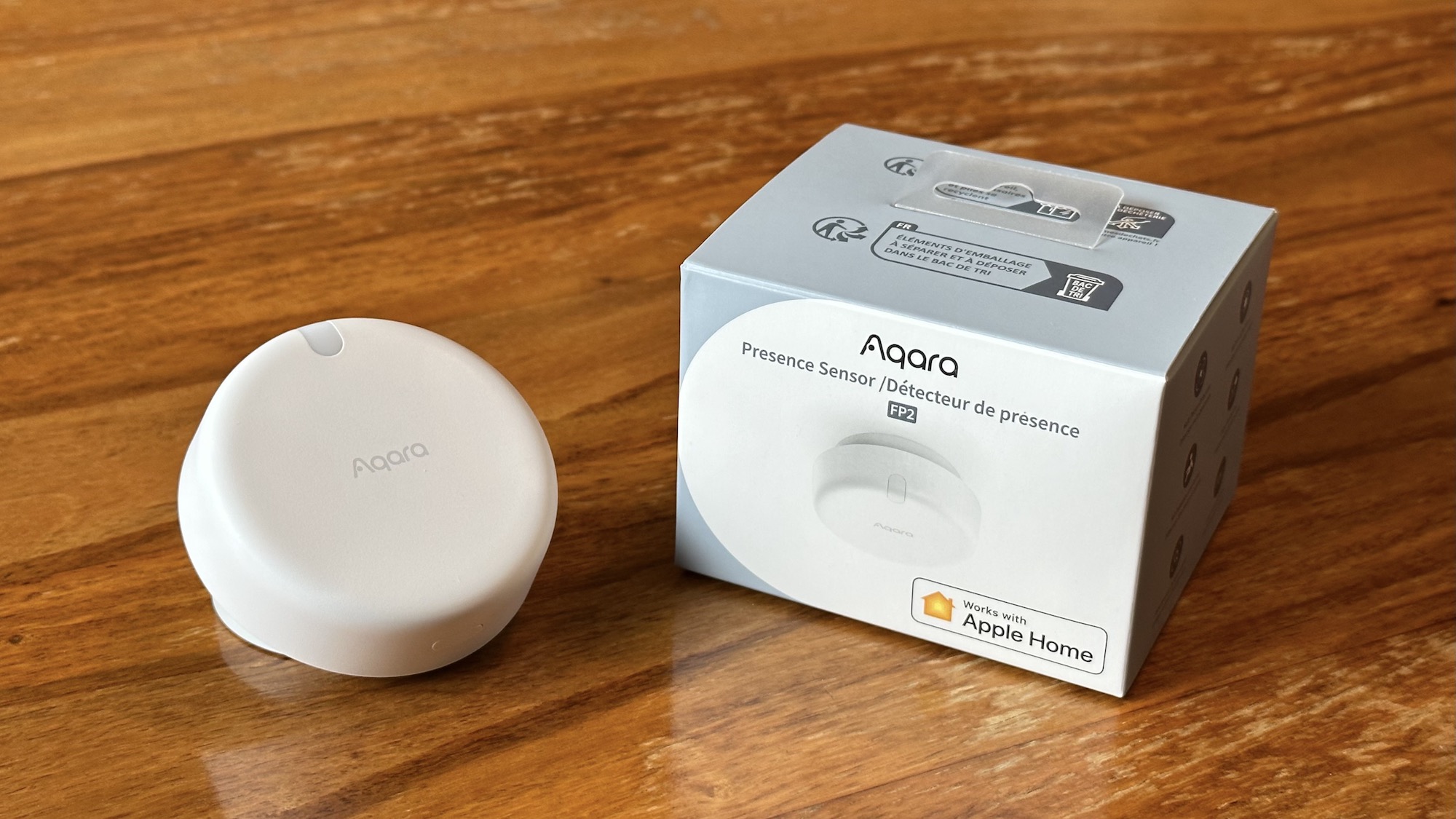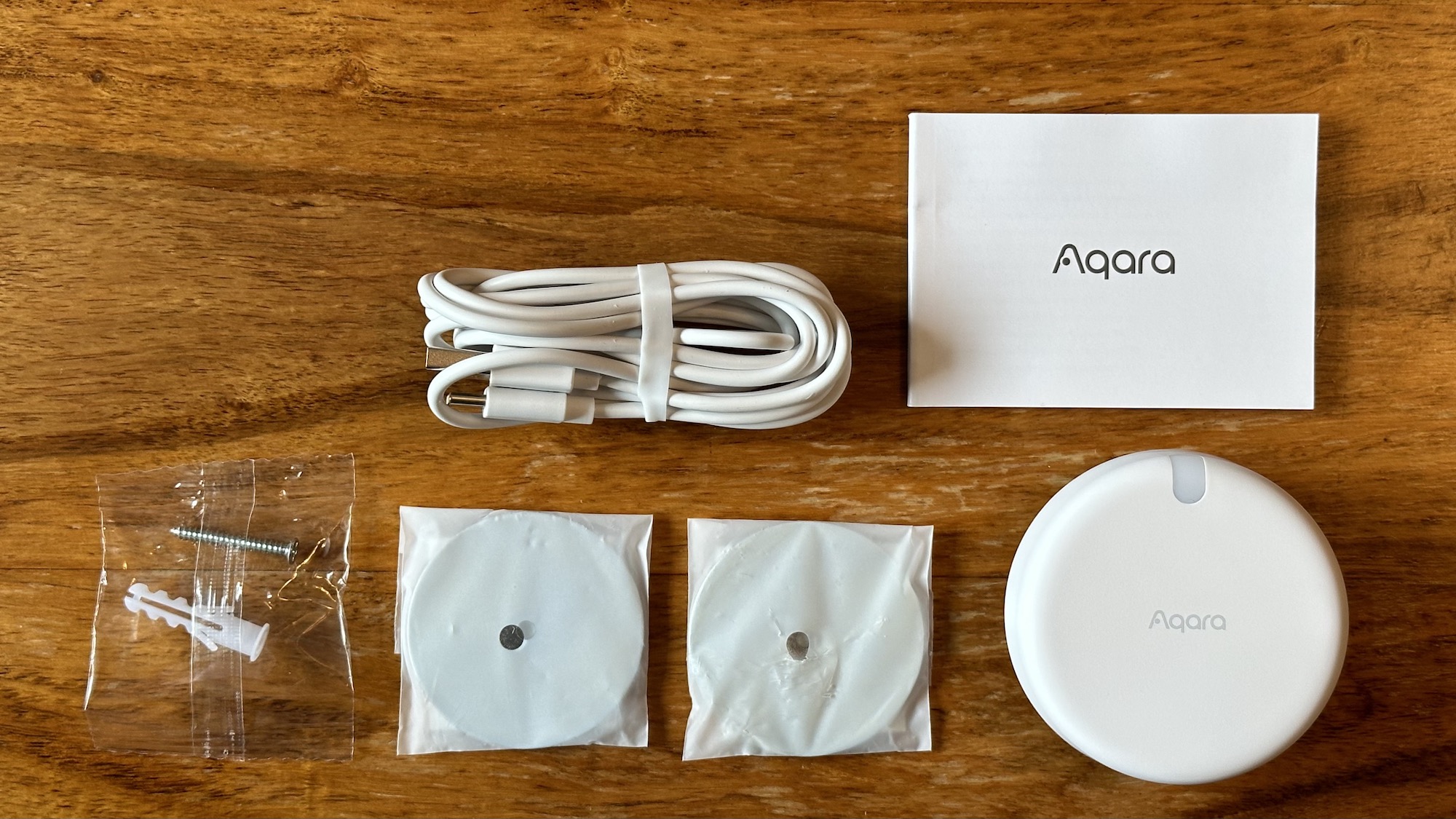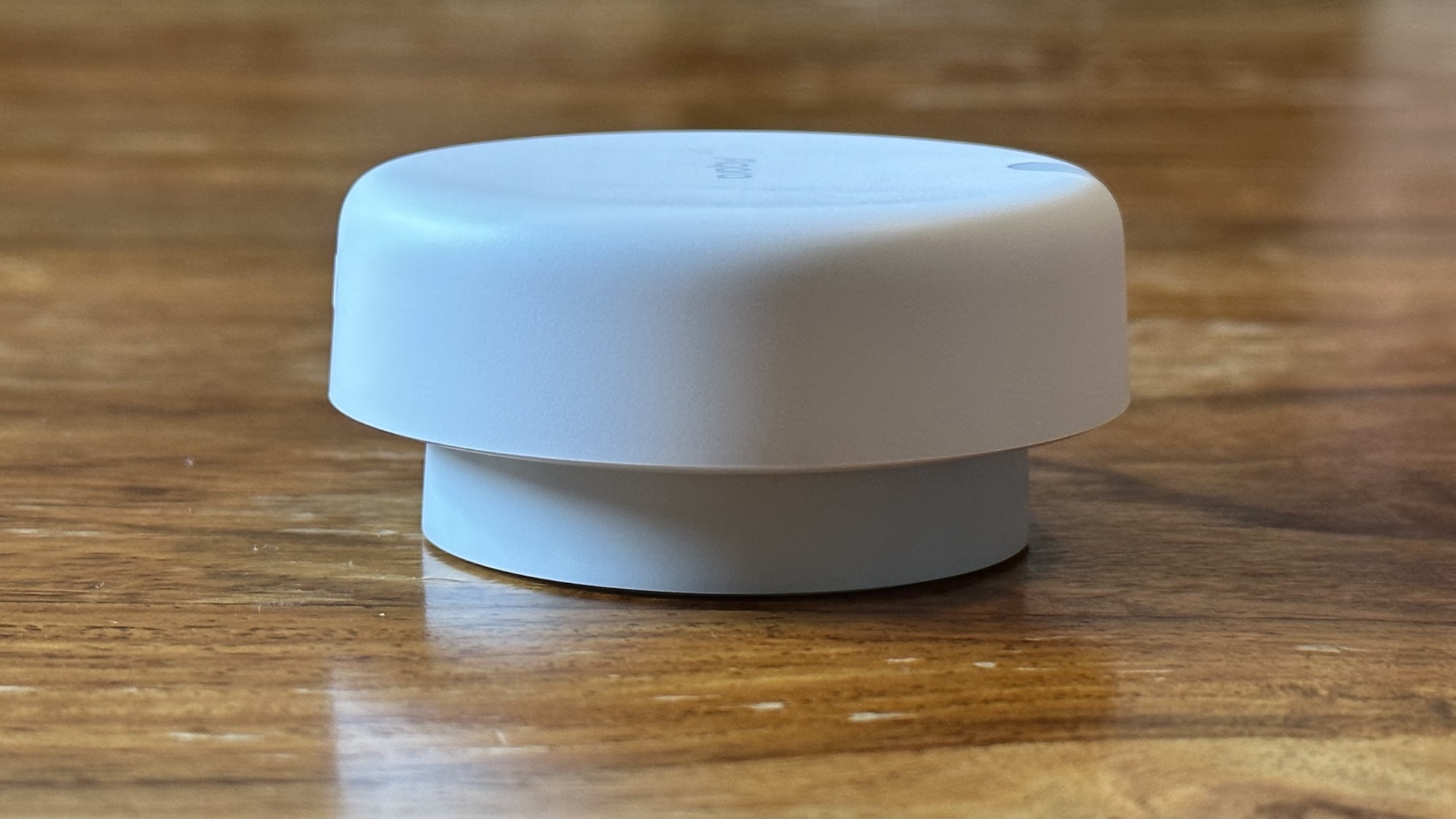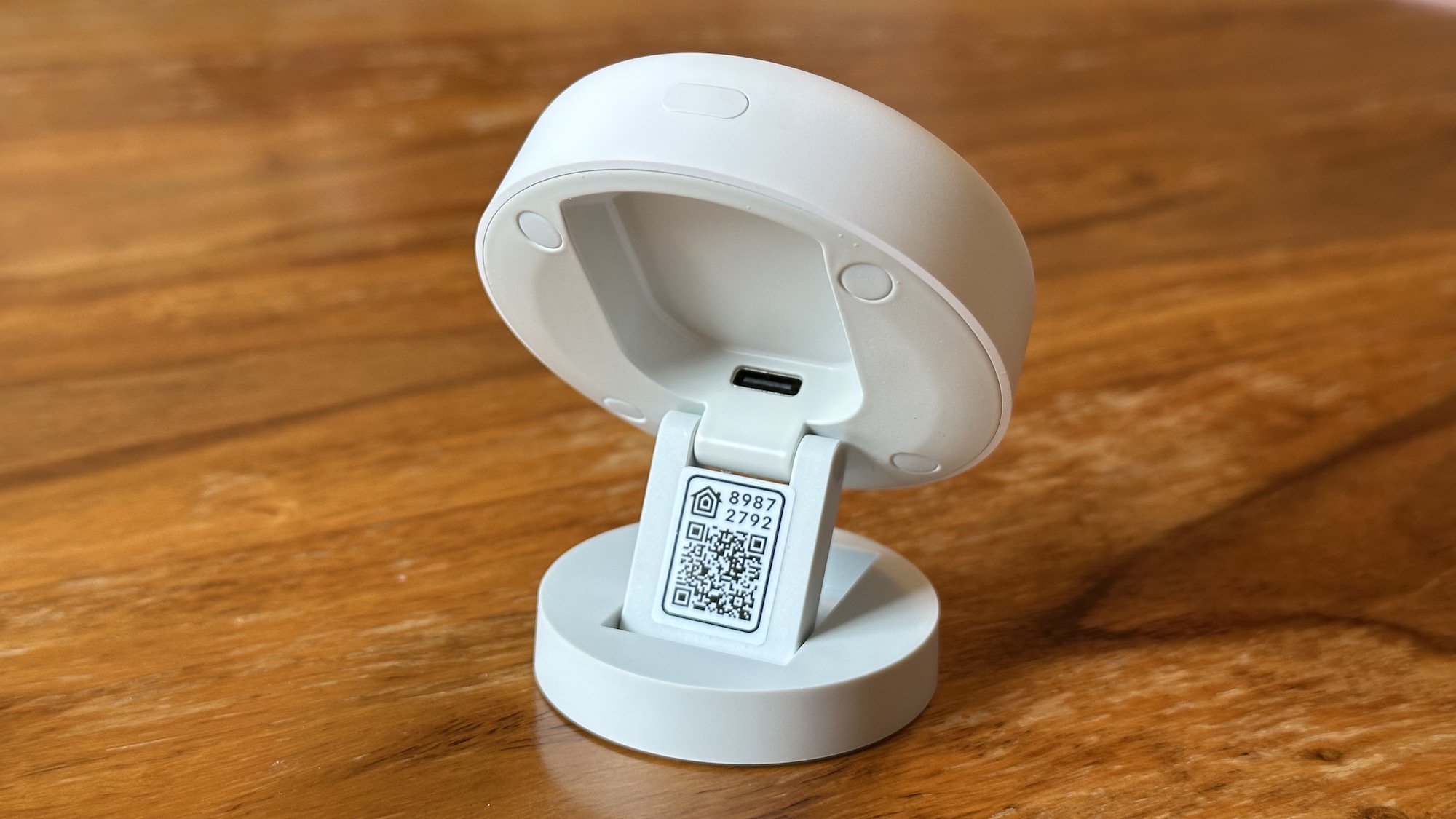Aqara this week released the Presence Sensor FP2 – a brand new millimeter wave sensor that goes far beyond the capabilities of more conventional motion sensors to facilitate powerful automations, with support for Apple HomeKit.

The sensor uses millimeter wave radar technology to detect human presence in a room with greater precision than traditional passive infrared sensors, allowing for more specific automations and a more reliable experience. Aqara says that FP2 detects even the slightest movement, such as breathing, to ascertain human presence. This level of precision means that users can set up automations to turn on lights and keep them on when someone is in an area, even when there is very minimal motion that more conventional sensors would not be able to sense, for example.

The sensor comes with a two meter USB-A to USB-C power cable, two adhesive magnetic mounting plates, a screw, a wall anchor, and an instruction manual. You need to provide your own USB-A wall adapter to power the device.
The sensor sports an extremely compact design with a rounded body and matte white finish. At the top, there is a pairing button and an ambient light sensor. The design is sufficiently discreet to tuck in the corner of a room or leave on a tabletop.

The base of the sensor swivels out and fully extends, helping you to position it exactly as you wish. The base is magnetic, allowing you to adhere it to one of the included magnetic plates if you plan to install the sensor on a wall or ceiling. Swivelling out the base also reveals the USB-C port required to power the device and a HomeKit pairing code sticker.

The FP2 is IPX5 rated against water and dust, which allows it to be installed in humid environments like bathrooms or even some outdoors areas.
While the Presence Sensor FP2 requires an Aqara hub, there are multiple options to choose from, such as the M1S or M2 hub. Setting up the FP2 follows the same process as many other Aqara accessories. Simply connect the FP2 to a power source, open the Aqara app, hold down the small button on the accessory, and follow the on-screen instructions.
To take full advantage of the FP2's features, you need to use the Aqara app. The sensor has separate modes depending on where you plan to position the sensor, each with subsequent options for fine-tuning to your exact needs. Users can set up various detection zones and targets, as well as exclude certain areas from the sensor to prevent movement in these areas triggering automations.
The app allows you to define up to 30 zones within a room, each with their own automations. After setting up these zones in the Aqara app, the configuration can be synced to Apple's Home app as multiple motion or occupancy sensors, allowing you to use the FP2 natively in a HomeKit setup and create automations. The built-in light sensor is also exposed to HomeKit.
The sensor can detect presence up to eight meters away and pinpoint the exact location of individuals in the room with extraordinary accuracy, as visible in the Aqara app. It can also track up to five people at once, allowing for the control of different zones based on the real-time location of each individual. The detection of presence is impressively instantaneous and noticeably more accurate than simpler motion sensor accessories.
The FP2 also offers some unique features such as fall detection in the Aqara app. Other capabilities, including posture, standing, sitting, and lying detection, are set to be added with an update to the device. The FP2 may even be able to support sleep monitoring and respiratory rate detection in the future via an update, according to Aqara.
With its range of advanced features, Presence Sensor FP2 is one of the most precise, versatile, and unique smart home sensors available on the market. At $82.99, it is costlier than a simple motion sensor, but it offers far better functionality.
The FP2 can function as up to 30 individual motion sensors in Apple's Home app with an extremely high level of sensitivity and accuracy, making it easy to recommend over buying a more limited motion sensor. Matter compatibility is set to come to the FP2 Presence Sensor via an over-the-air update, and Aqara has more features planned for the device in the future, making it a good choice for any smart home setup.
The need for constant power via USB-C is virtually the only caveat to the FP2, since many of the less capable motion sensors on the market use battery power, which makes it easy to place them exactly where you want them. The need for wired power means you just have to think a little more carefully about where you plan to use the FP2.

The Presence Sensor FP2 is available from Amazon in North America and Europe, as well as selected Aqara retailers worldwide. Aqara is currently offering a 15% discount on the new device on the Amazon through April 22 with the following discount codes:
Note: Aqara provided MacRumors with a FP2 Presence Sensor for the purpose of this review. No other compensation was received.
This article, "Review: Aqara's Presence Sensor FP2 Is a Unique, Ultra-Accurate HomeKit Accessory" first appeared on MacRumors.com
Discuss this article in our forums
Source: TechRadar

The sensor uses millimeter wave radar technology to detect human presence in a room with greater precision than traditional passive infrared sensors, allowing for more specific automations and a more reliable experience. Aqara says that FP2 detects even the slightest movement, such as breathing, to ascertain human presence. This level of precision means that users can set up automations to turn on lights and keep them on when someone is in an area, even when there is very minimal motion that more conventional sensors would not be able to sense, for example.

The sensor comes with a two meter USB-A to USB-C power cable, two adhesive magnetic mounting plates, a screw, a wall anchor, and an instruction manual. You need to provide your own USB-A wall adapter to power the device.
Design
The sensor sports an extremely compact design with a rounded body and matte white finish. At the top, there is a pairing button and an ambient light sensor. The design is sufficiently discreet to tuck in the corner of a room or leave on a tabletop.

The base of the sensor swivels out and fully extends, helping you to position it exactly as you wish. The base is magnetic, allowing you to adhere it to one of the included magnetic plates if you plan to install the sensor on a wall or ceiling. Swivelling out the base also reveals the USB-C port required to power the device and a HomeKit pairing code sticker.

The FP2 is IPX5 rated against water and dust, which allows it to be installed in humid environments like bathrooms or even some outdoors areas.
Set Up, Functionality, and HomeKit Support
While the Presence Sensor FP2 requires an Aqara hub, there are multiple options to choose from, such as the M1S or M2 hub. Setting up the FP2 follows the same process as many other Aqara accessories. Simply connect the FP2 to a power source, open the Aqara app, hold down the small button on the accessory, and follow the on-screen instructions.
To take full advantage of the FP2's features, you need to use the Aqara app. The sensor has separate modes depending on where you plan to position the sensor, each with subsequent options for fine-tuning to your exact needs. Users can set up various detection zones and targets, as well as exclude certain areas from the sensor to prevent movement in these areas triggering automations.
The app allows you to define up to 30 zones within a room, each with their own automations. After setting up these zones in the Aqara app, the configuration can be synced to Apple's Home app as multiple motion or occupancy sensors, allowing you to use the FP2 natively in a HomeKit setup and create automations. The built-in light sensor is also exposed to HomeKit.
The sensor can detect presence up to eight meters away and pinpoint the exact location of individuals in the room with extraordinary accuracy, as visible in the Aqara app. It can also track up to five people at once, allowing for the control of different zones based on the real-time location of each individual. The detection of presence is impressively instantaneous and noticeably more accurate than simpler motion sensor accessories.
The FP2 also offers some unique features such as fall detection in the Aqara app. Other capabilities, including posture, standing, sitting, and lying detection, are set to be added with an update to the device. The FP2 may even be able to support sleep monitoring and respiratory rate detection in the future via an update, according to Aqara.
Bottom Line and How to Buy
With its range of advanced features, Presence Sensor FP2 is one of the most precise, versatile, and unique smart home sensors available on the market. At $82.99, it is costlier than a simple motion sensor, but it offers far better functionality.
The FP2 can function as up to 30 individual motion sensors in Apple's Home app with an extremely high level of sensitivity and accuracy, making it easy to recommend over buying a more limited motion sensor. Matter compatibility is set to come to the FP2 Presence Sensor via an over-the-air update, and Aqara has more features planned for the device in the future, making it a good choice for any smart home setup.
The need for constant power via USB-C is virtually the only caveat to the FP2, since many of the less capable motion sensors on the market use battery power, which makes it easy to place them exactly where you want them. The need for wired power means you just have to think a little more carefully about where you plan to use the FP2.

The Presence Sensor FP2 is available from Amazon in North America and Europe, as well as selected Aqara retailers worldwide. Aqara is currently offering a 15% discount on the new device on the Amazon through April 22 with the following discount codes:
- Amazon North America: FP2USCA1 (applicable to Amazon US & Canada)
- Amazon Europe: EU5PSFP2 (applicable to Amazon France, Germany, Italy, Spain & UK)
Note: Aqara provided MacRumors with a FP2 Presence Sensor for the purpose of this review. No other compensation was received.
This article, "Review: Aqara's Presence Sensor FP2 Is a Unique, Ultra-Accurate HomeKit Accessory" first appeared on MacRumors.com
Discuss this article in our forums
Source: TechRadar